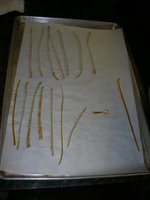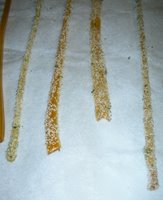THE GREAT GNOCCHI MASSACRE
 Our return to the Garde Manger Station continues. Chef W. is always cool about doing extra dishes in our spare time after service and for tonight we're planning on doing the Tuesday recipe, a molded salad with goat cheese when we're finished with the two dishes we're serving to the restaurant tonight.
Our return to the Garde Manger Station continues. Chef W. is always cool about doing extra dishes in our spare time after service and for tonight we're planning on doing the Tuesday recipe, a molded salad with goat cheese when we're finished with the two dishes we're serving to the restaurant tonight.More after class on the jump...
DISH: Purée of Carrot Soup With Leeks, Sorrel, And Dill, Potage Crécy Auc Poireaux, Oseille, Et Aneth
RECIPE:
The Soup
1 KG Carrots
100 G Onions
200 G Leek, White & Tender Green Parts Only
50 G Butter
2 L Butter
2 L Chicken Stock
100 G Potato
Salt & Freshly Ground Pepper
The Garnish
160 G Pain De Mie
70 G Butter
80 G Carrot, Cut Macédoine
120 G Leek, White With Some Pale Green
15 G Sorrel Leaves, Chiffonade
40 G Dill
125 ML Blended Olive Oil
Finishing the Soup
200 ML Heavy Cream
75 G Butter
Dill Sprigs
Procedure:
SOUP Peel the carrots and onions and clean the leeks. If the carrots are extremely large and woody, cut them lengthwise down the middle and snap out the core with a paring knife. Émincez these vegetables and sweat them in the butter until tender but with no color, and then season them lightly with salt. Pour in the stock and add the potato. Cover the pot and simmer the soup until all the vegetables are tender. Stir the soup from time to time to make sure that none of the vegetables stick to the bottom of the pot and burn.
GARNISH Meanwhile, cut the bread into 3/8-inch dice and sauté in 40 G of the butter until golden. Drain on paper towels to absorb the fat. Cook the carrot garnish à l'anglaise and refresh. Émincez the leeks and sweat them in the remaining butter until tender, adding the sorrel at the last minute and allowing it to soften. Season them with salt and pepper and set aside. Purée the dill with oil in a bldender until smooth and very green.
FINISHING THE SOUP When all the soup vegetables are compltely soft, purée the soup, in batches in a blender. Strain the soup through a china cap and return it to the heat. Add the heavy cream and bring the soup back to a simmer. Adjust the seasoning and consistency of the soup as needed. Add more stock if the soup is too thick and swirl the butter into the hot soup. Reheat the carrots and leeks separately and stack a portion of them in the center of each hot soup bowl, starting with the carrots on the bottom. Serve the hot soup oured around the warmed garnish and topped with the croutons and a dill sprig. Acidulate 1 tablespoon of the dill oil and trace a circle of it over the top of the soup.
DISH: Ricotta Gnocchi With Braised Greens, Mushrooms, and Prosciutto, Gnocchi De Lait Caillé Et Vergure Braisée, Champignons, Et Jambon De Parme
RECIPE:
The Gnocchi
500 G Ricotta, Well Drained
2 Eggs
60 G All-Purpose Flour* (CHANGE THIS TO 90G)
4 Tablespoons Grated Parmesan Cheese (CHANGE THIS TO 6 TBSP)
Salt & Freshly Ground Pepper
The Garnish and Finish
250 G Oyster or Other Exotic or Wild Mushrooms, Stemmed
100 ML Blended Olive Oil
150 G Greens For Braising (Baby Bok Choy, Lettuce Hearts, Arugula)
Cut in 2-inch Pieces
25 G Prosciutto, Cut in 1-inch Triangles
500 ML Chicken Stock
150 G zbutter
5 to 6 Fresh Sage Leaves, Cut in Julienne
25 G Parmesan Cheese, Finely Grated
Balsamic Vinegar
Procedure:
GNOCCHI Blend the ricotta and egg briefly in a food processor. Stop the machine and add the flour, cheese, and a bit of seasoning. Process again until just mixed. Place the mixture in a bowl set over ice and refrigerate until needed. Form the mixture in teaspoon-size quenelles and poach them in lightly salted simmering water. The quenelles will sink to the bottom when they enter the water and then gradually rise to the top. Count 4 minutes of cooking time after they rise to the top. Refresh in ice water, drain, and set aside.
GARNISH AND FINISH Sauté the mushrooms in 30 ML of oil, season, and set aside. Per order: Warm a tablespoon of oil ina small sauteuse. Add 5 to 6 musroom pieces, 6 to 8 pieces of greens, and 3 pieces of prosciutto, and cook gently until the greens have wilted and are crisp-tender. Pour in 65 ML of stock. Add 1 Tablespoon butter, 1 teaspoon cheese, and the equivalent of 1 sage leaf cut in julienne. Bring to a simmer and emulsify the sauce. Meanwhile, drop 4 to 5 gnocchi in some hot salted water and reheat briefly. Drain and add them to the sauce and swirl the pan to baste them with the sauce. Adjust the seasoning. Arrange all the elements decoratively in a wide shallow bowl and finish with a few drops of balsamic vinegar.
BREAKDOWN:
 The carrot soup? I didn't work on it tonight--it's what I'll do next time our group goes through Garde Manger. It was tasty though and not gummy like the tomato soup we did last class. It was a bright spot in what otherwise was an unmitigated disaster. I'm renaming the post from "Carrot Soup, Gnocchi & Molded Salad," to "The Great Gnocchi Massacre." Do not use the recipe above unless you make a significant change, namely to the flour. We made small quenelles of the gnocchi mixture which was rather fluid after processing it. The quenelles were placed on strips of parchment paper and put in the refrigerator to set while we got some seasoned chicken stock boiling.
The carrot soup? I didn't work on it tonight--it's what I'll do next time our group goes through Garde Manger. It was tasty though and not gummy like the tomato soup we did last class. It was a bright spot in what otherwise was an unmitigated disaster. I'm renaming the post from "Carrot Soup, Gnocchi & Molded Salad," to "The Great Gnocchi Massacre." Do not use the recipe above unless you make a significant change, namely to the flour. We made small quenelles of the gnocchi mixture which was rather fluid after processing it. The quenelles were placed on strips of parchment paper and put in the refrigerator to set while we got some seasoned chicken stock boiling. Only it didn't make much difference--the quenelles didn't hold up in the poaching liquid. Small parts of them broke off and then when the gnocchi were removed to a half-sheet pan, many of them broke, no matter how gently I handled them. I've had ricotta gnocchi before and they looked nothing like this, more like potato gnocchi but lighter. I'd expected these gnocchi to be much heavier, at least to stay in one piece.
Only it didn't make much difference--the quenelles didn't hold up in the poaching liquid. Small parts of them broke off and then when the gnocchi were removed to a half-sheet pan, many of them broke, no matter how gently I handled them. I've had ricotta gnocchi before and they looked nothing like this, more like potato gnocchi but lighter. I'd expected these gnocchi to be much heavier, at least to stay in one piece. If the gnocchi were to be cooked and then served, it might be one thing, but the real problem is that they were then reheated in a light sauce with bok choy, mushrooms and ham for service and they just couldn't stand up to being moved much.
If the gnocchi were to be cooked and then served, it might be one thing, but the real problem is that they were then reheated in a light sauce with bok choy, mushrooms and ham for service and they just couldn't stand up to being moved much.It was an extremely frustrating night. I tried everything to make the situation better including stashing the uncooked gnocchi in freezers around the restaurant kitchen, thinking that at least if the gnocchi were frozen, they'd keep their shape from the paper to the pot. It helped a little and a few less gnocchi broke during the process but too many were still falling apart. The only thing to do was to keep pressing forward through service.
 The result, at left, was possibly the worst dish we'd served in the past two months. I can't remember one that looked worse. We tried to think back on what we might have done wrong but our measurements were exact. I noticed at one point that while being reheated with the sauce for service the gnocchi were being shaken in the saute pan (a tic in this case as there wasn't a chance they could be burned). I noted this, and after it was established that blame wasn't being assigned, it helped slightly, though as you can see the dish still looked like a sorry cheese soup.
The result, at left, was possibly the worst dish we'd served in the past two months. I can't remember one that looked worse. We tried to think back on what we might have done wrong but our measurements were exact. I noticed at one point that while being reheated with the sauce for service the gnocchi were being shaken in the saute pan (a tic in this case as there wasn't a chance they could be burned). I noted this, and after it was established that blame wasn't being assigned, it helped slightly, though as you can see the dish still looked like a sorry cheese soup.We ditched the third recipe we were going to do in our extra time and went through the gnocchi recipe again. It turned out that there was a simple explanation for the disaster, the recipe in the book was wrong. We doubled the flour and tried it again. This time it worked, the gnocchi didn't fall apart but now they tasted too much like flour. In the end we changed the recipe from 60 G of flour to 90 G and the four tablespoons of grated parmesan cheese to six tablespoons.
 Meanwhile, in pastry, things were going better with an interesting development on sugar garnish. We'd done pulled strands of sugar before and used them as garnish leaning on or angled off of ice creams, cakes and such but the chef did something different this time. Granulated sugar and very finely minced mint was cooked briefly in the oven to dry them out. They were then removed, passed through a drum sieve to turn the mixture into a fine, mixed powder and the sugar strands were coated with it.
Meanwhile, in pastry, things were going better with an interesting development on sugar garnish. We'd done pulled strands of sugar before and used them as garnish leaning on or angled off of ice creams, cakes and such but the chef did something different this time. Granulated sugar and very finely minced mint was cooked briefly in the oven to dry them out. They were then removed, passed through a drum sieve to turn the mixture into a fine, mixed powder and the sugar strands were coated with it. The powder actually made me want to taste the garnish which I wouldn't eat otherwise (I'd use it on the plates but the last thing I need to do when eating a dessert is to be eating pure, hardened sugar). The mint and sugar powder added a nice touch taste-wise and aesthetically. Practically, it helped make use of pulled sugar that the humidity had made slightly sticky-- the dried powder sticks to the sugar! Neat trick, huh?
The powder actually made me want to taste the garnish which I wouldn't eat otherwise (I'd use it on the plates but the last thing I need to do when eating a dessert is to be eating pure, hardened sugar). The mint and sugar powder added a nice touch taste-wise and aesthetically. Practically, it helped make use of pulled sugar that the humidity had made slightly sticky-- the dried powder sticks to the sugar! Neat trick, huh?





0 Comments:
Post a Comment
<< Home